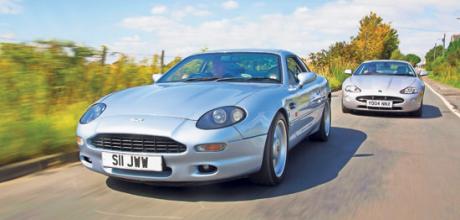Jaguar XK8 4.0 X100 vs. Aston Martin DB7 3.2 Coupe

There’s an interloper currently in my garage. But it’s not a neighbour’s cat or the chest freezer my wife has wanted in there for some time but rather an Aston Martin.
As the new editor of Aston Martin Driver, I’ve been given the keys to Kelsey Publishing’s DB7 3.2 and since it’s parked next to my 2000 Jaguar XK8 4.0 X100, I can’t help but compare the two. The pair are actually closely related with the Aston starting life as the Keith Helfet-designed XJ41 which he worked on throughout the Eighties. When the project was canned by parent company Ford in 1989 due to rising costs, Keith, disappointed the design wouldn’t reach production, discovered the body would fit onto the XJS platform, resulting in a cheaper to- produce car. After being told this by Jaguar’s engineering director, Jim Randle, TWR agreed to develop the reborn car.
Ever the canny operator, TWR’s Tom Walkinshaw quickly realised the new car would have higher list price if badged as another of Ford’s recent purchases, Aston Martin. So when the finished coupe went on sale in 1994, it had been given the Aston grille by TWR’s chief designer, a certain Ian Callum, and christened the DB7.
The XK8 was also initially designed by Keith and was then finished for production by his Jaguar design colleague, Fergus Pollock. Due to their shared design parentage, the two coupes have almost identical lines, both having the sort of soft, flowing curves that define Keith’s long Jaguar career. I think the DB7 is slightly prettier, the beautiful Coke-bottle shaped rear haunches and the better profiled boot lid especially.
Despite these similarities, the Aston was always the more expensive of the two. When new, this 1997 3.2 example would have been £82,500, or £34,550 more than an XK8 4.0 at the time, making it easy to understand why Walkinshaw persuaded Ford to swap brands.
I’ve drivenaDB7 several times over the years, the first being in 1998 for a magazine photoshoot and more recently for a twin test with an XKR in the June 2019 issue of JW. But these were brief dalliances; to have access to one over a longer period has revealed much, mainly that the car wasn’t as well-built as the Jaguar. The interior features too much switchgear swiped from Ford’s parts bins for an £80k coupe while the panel of cheap-looking veneer that’s been crudely tacked onto the fascia belongs in a motorhome. The overall fit and finish can’t compete with the Jaguar’s interior either, which looks and feels more coherent and less of a cost-saving exercise than the DB7’s.
Yet the biggest let down is how the Aston drives. Using a supercharged version of Jaguar’s AJ6 3.2-litre, at 5.6 seconds it might be 0.8 seconds faster to 60mph than the XK8 4.0 but not only does the gruffness remind me of a car produced ten or even 20 years earlier, but despite forced induction resulting in 335bhp, it needs to be worked much harder than the Jaguar. This isn’t helped by the four-speed automatic gearbox which even in the mid Nineties was considered as old-fashioned.
Despite what the figures say, my 270bhp XK8 X100 feels faster to respond than the DB7, sounding less strained when it does so. Yes there’s a growl when under heavy acceleration but it’s less intrusive than the loud supercharger wail of the Aston.
Although the XK8 also uses a section of the XJS’s chassis, thanks to updated suspension, it handles better than the DB7 that was based entirely on the older car. This results in it feeling like it was produced in the Seventies or Eighties and not 25 years ago. I find it difficult to believe the Aston is today worth between £15k and £30k whereas I’d be lucky to get seven grand for my Jaguar. I guess that’s what rarity does since a little over 90,000 XKs of all varieties were produced compared to 7000 DB7s.
Even I have to admit that despite its confused heritage, ancient drivetrain and parts-bin interior, that scarcity together with its beautiful looks gives theAston Martin DB7 more of an allure than the mass-produced Jaguar. Two weeks in and I still have a tingle of excitement whenever I open the garage door and see that famed winged badged on that low nose.
As much as the DB7 is an interloper, it’s still a welcomed one and not just because its presence leaves not enough room for that freezer
DUE TO THEIR SHARED DESIGN PARENTAGE, THE TWO COUPES HAVE ALMOST IDENTICAL LINES

